Boost Your Affiliate Profits: A Deep Dive into Postback and Backlink URLs

Postback URLs and Backlinks — your secret weapons for boosting campaigns and earnings. In the digital marketing arena, these tools are not just jargon; they're game-changers. Postback URLs bring precision to tracking conversions, sidestepping the pitfalls of browser-based methods, while Backlinks propel your site's visibility and credibility sky-high.
Understanding these powerful elements is crucial whether you're just stepping into the affiliate marketing world or looking to refine your strategies. Ready to unlock your marketing potential? Let's get started.
The essence of Postback URL and its place in affiliate marketing
Postback URL also known as server-to-server (S2S) tracking, is the method that facilitates the direct communication of data between servers, thereby ensuring a high level of reliability and security. Unlike client-side tracking methods that rely on the user's browser, Postback URLs operate in the background, unseen by the user, to transfer essential information about conversions or other key actions from the advertiser's server back to the affiliate network's server.
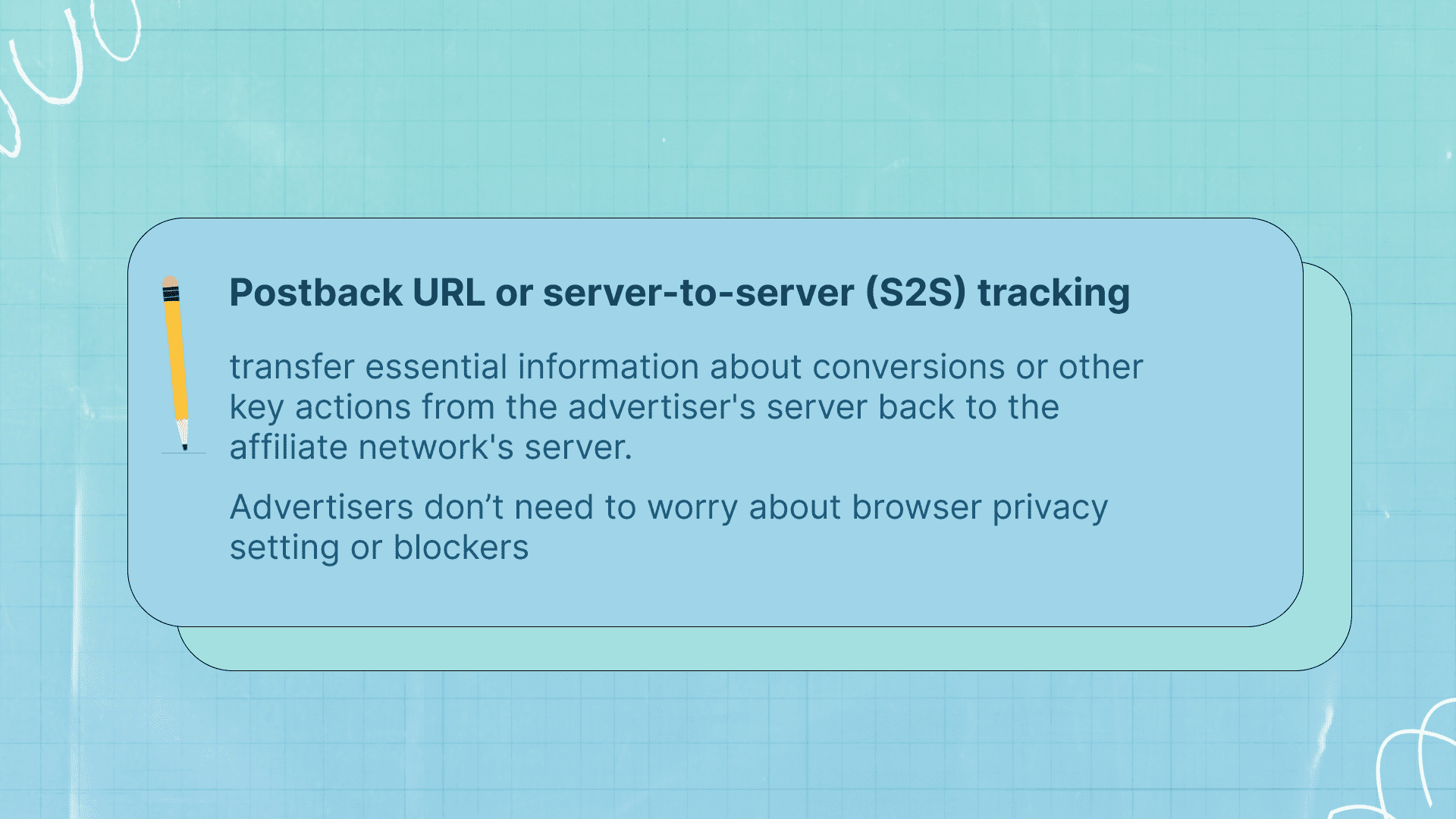
The terminology “server-to-server” underscores the method's core functionality: the exchange of data happens directly between two servers, eliminating the dependence on the user's browser to carry out tracking. This is especially critical in environments where traditional tracking methods, such as cookies, are less effective due to privacy settings or blockers. When a user clicks on an affiliate link, a unique identifier is generated and passed through the click. Should this click lead to a conversion, the advertiser's server communicates this event back to the affiliate's server using the Postback URL, ensuring the affiliate is credited for the conversion.
This server-to-server method contrasts with another common tracking method in affiliate marketing: pixel tracking. Pixel tracking, or browser-based tracking, involves embedding a tiny, invisible piece of code (the “pixel”) on the confirmation or “thank you” page that loads after a conversion. When the page is accessed, the pixel fires, signalling a conversion event back to the tracking server. Although effective within web browsers, pixel tracking faces challenges like ad blockers and cookie restrictions, which can impede its reliability.
Understanding flow: a roadmap of a Postback URL tracking
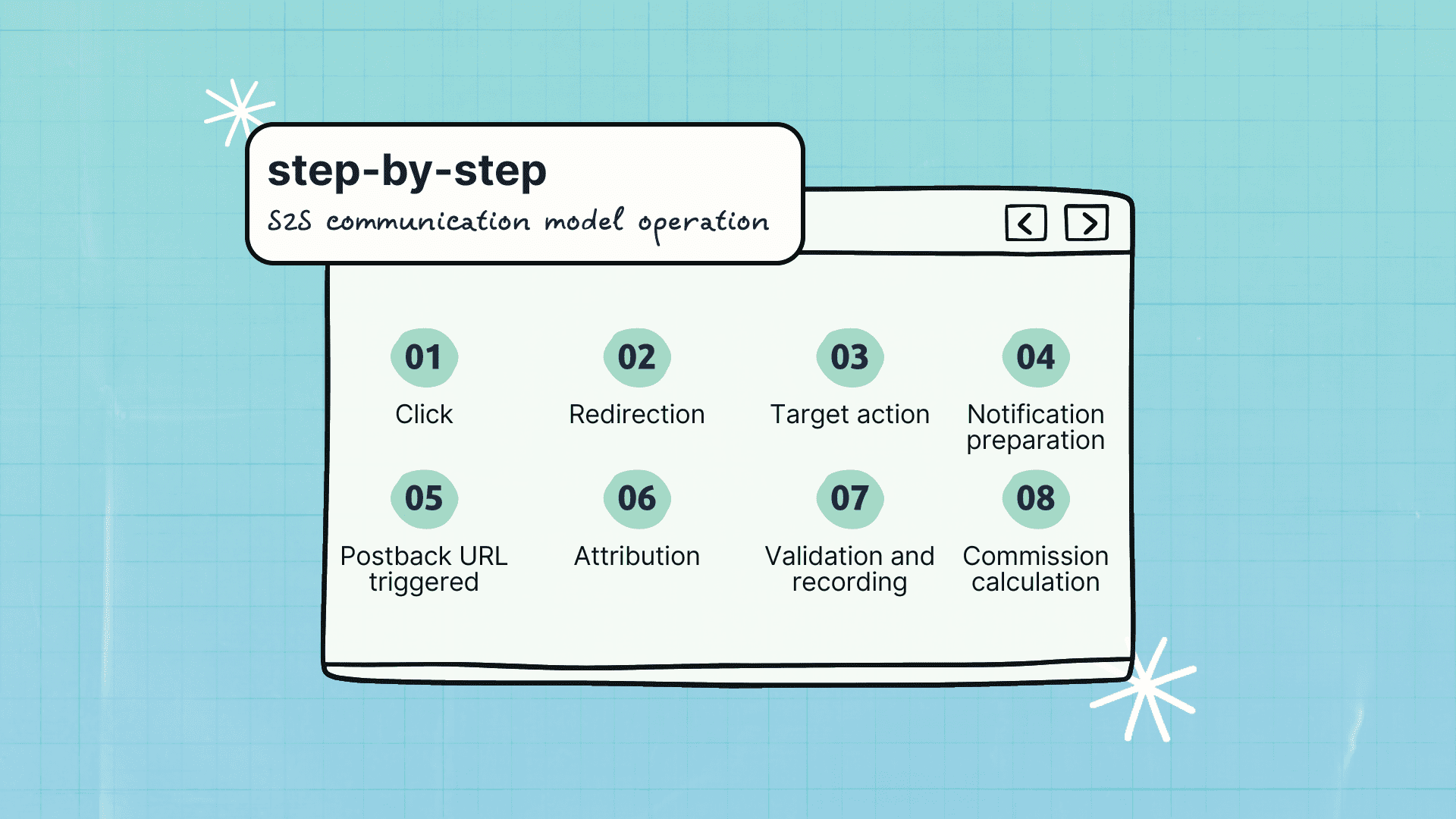
Here’s a condensed explanation and a straightforward list of steps on how the server-to-server communication model operates:
- Click. The user clicks an affiliate link. A unique transaction ID is generated.
- Redirection. The user is redirected to the advertiser's site/landing page, carrying the transaction ID.
- Target action. The user completes a conversion (e.g., purchase) on the advertiser's site, while conversion details are recorded with the transaction ID.
- Notification preparation. The advertiser's server prepares a notification with conversion and transaction ID.
- Postback URL triggered. Notification sent to affiliate network via Postback URL, including transaction ID and conversion details.
- Attribution. The affiliate network matches the transaction ID to the affiliate responsible for the click.
- Validation and recording. The network validates the conversion and records it, attributing it to the correct affiliate.
- Commission calculation. The network calculates the commission based on conversion details.
- Reward. The affiliate is credited with the conversion; the commission is prepared for payout.
This concise list effectively captures the essence of Postback URL tracking, highlighting its role in ensuring accurate attribution and fair compensation in affiliate marketing.
The fundamentals of conversion tracking
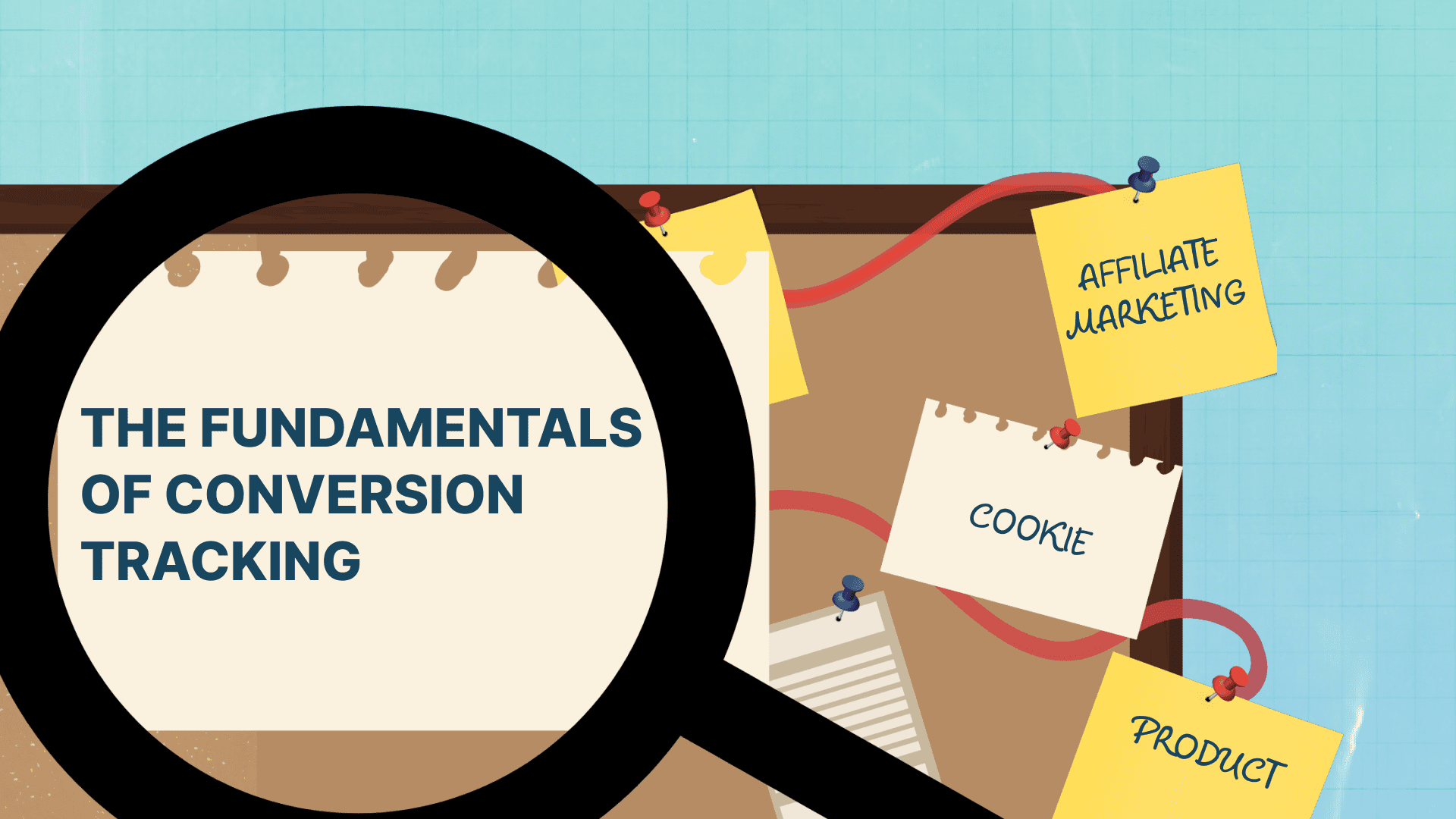
In affiliate marketing, conversion tracking is a bit like a digital breadcrumb trail that helps to see what happens after someone clicks on an affiliate link. Imagine you're a detective, and your mission is to find out whether those clicks on a product link affiliate shared are leading to people buying something. When someone clicks on the link, a small piece of data called a “cookie” gets dropped into their browser. This cookie is like a secret handshake between the seller's website and the affiliate’s landing page. It tells the seller that this sale came from a particular affiliate. Every time a purchase is made through this link, the tracking system notices this handshake and goes, “Aha! Let's give credit (and a commission) to our affiliate detective!” This way, affiliates get rewarded for the purchases made because of their recommendation. It's a neat system that keeps track of the success of affiliates’ links and ensures they get credit for the hard work they put into promoting products.
Additionally, the Postback URL can convey various other details, such as the amount of payment, the timing of the conversion, the order number, etc., depending on the specific macros (or tokens) chosen for tracking. This allows for a comprehensive capture of conversion-related data, tailored to the needs of the tracking strategy.
Let's get practical: an example of a Postback URL
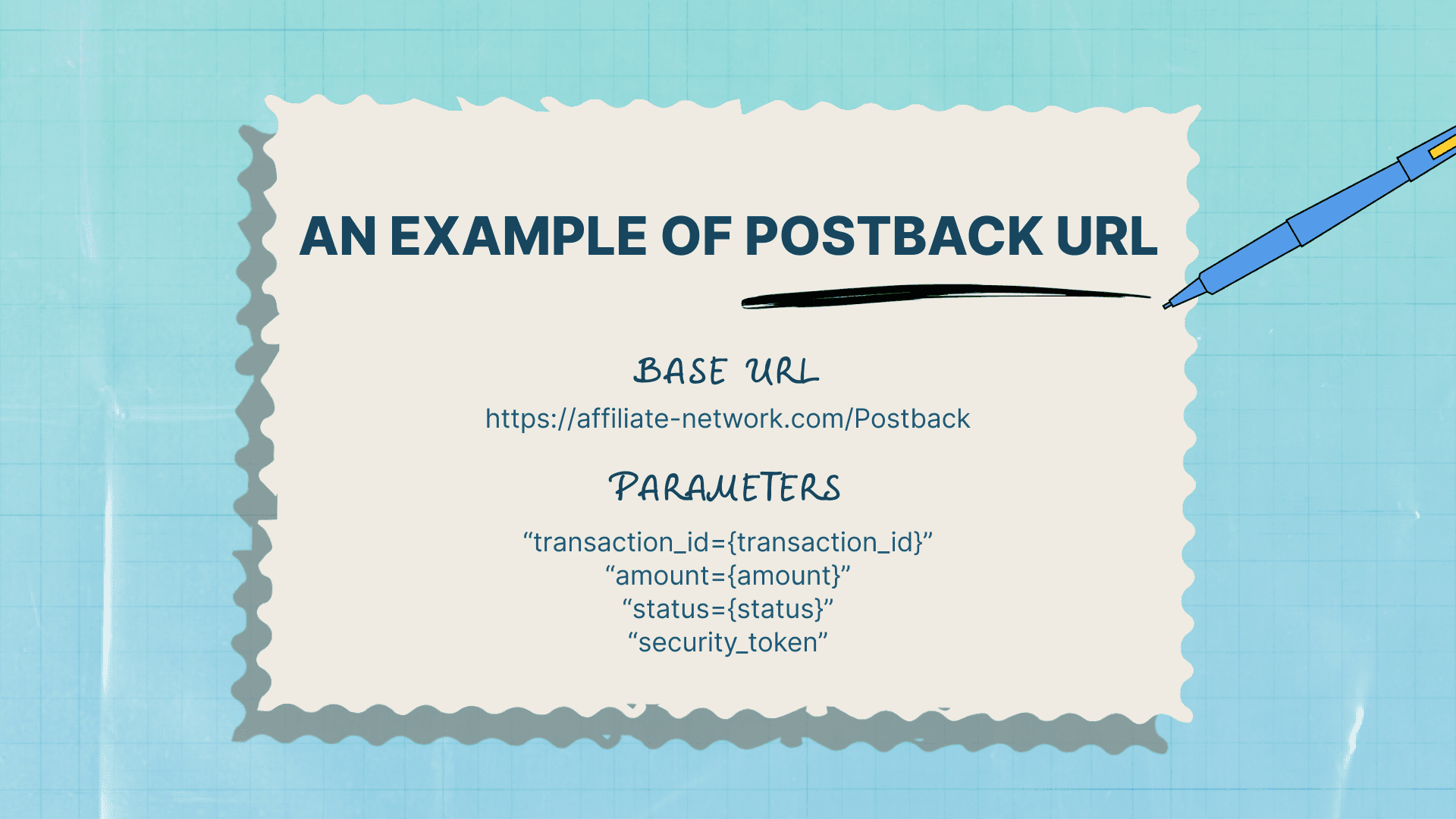
Let's take the role of a chemist and try to understand the Postback URL formula and its components by example:
https://affiliate-network.com/postback?transaction_id={transaction_id}&amount={amount}&status={status}&security_token=ABC123
Let's break down the URL into each element:
1. Base URL
- https://affiliate-network.com/Postback
This is the endpoint provided by the affiliate network or platform where the Postback data should be sent. It is the URL to which the advertiser's server sends a request when a conversion happens.
2. Parameters
The URL contains several query parameters that transmit specific details about the conversion event. These are key-value pairs separated by “&”.
- “transaction_id={transaction_id}”: A unique identifier for the conversion event. This ID is used to match the conversion back to the click or impression that initiated it.
- “amount={amount}”: The monetary value of the conversion. For a sale, this would be the purchase amount. For leads, it might be a predefined value.
- “status={status}”: The status of the conversion (e.g., completed, pending, rejected). This allows the affiliate system to understand the state of the event.
- “security_token=ABC123”: A static or dynamic value used to validate the authenticity of the Postback call. This is a security measure to prevent fraudulent reporting.
Each of these parameters plays a crucial role in accurately tracking and crediting conversions in affiliate marketing campaigns. The “transaction_id” ensures that each event is uniquely accounted for, the “amount” and “status” provide details necessary for compensating affiliates correctly, and the “security_token” helps maintain the integrity of the reporting process by ensuring that only legitimate Postbacks are considered.
HilltopAds’ Postback link parameters

If we're getting down to business, here are the parameters you should be sure to mention in your Postback URL when partnering with HilltopAds:
- {{ctoken}} — Unique ID of the conversion;
- {{zoneid}} — Traffic source identifier;
- advertiserID — Advertiser ID.
HilltopAds also integrates seamlessly with these extra parameters:
- {{geo}} — ISO country code;
- {{adid}} — Ad/banner identifier;
- {{campaignid}} — Campaign identifier;
- {{lang}} — Visitor language HTTP_ACCEPT_LANGUAGE e.g. en-en;
- {{category}} — Category Adult/Mainstream;
- {{currency}} — Conversion currency;
- {{cpmbid}} — CPM rate for campaign;
- {{price}} — For CPM campaigns, this placeholder provides the price of 1 ad impression. For CPC campaigns, it provides the price of 1 click on the ad;
- {{browsername}} — Browser name.
Benefits of Postback links’ tracking for all actors

Postback URLs are indispensable for affiliates, offering a robust framework for accurate tracking. Here's why they are so important:
- Accurate tracking. Postback URLs ensure precise tracking by allowing direct server-to-server communication, avoiding the pitfalls of cookie-based methods.
- Real-time data. They enable immediate access to user action data, allowing for swift decision-making and campaign adjustments.
- Fraud prevention. With direct data transmission, Postback URLs reduce the risk of fraudulent activities by ensuring that only legitimate conversions are counted.
- Enhanced optimization. Detailed conversion data helps in fine-tuning marketing strategies for better performance by identifying the most effective campaigns.
- Automated reporting. Postback URLs automate the reporting process, minimizing manual errors and saving time.
- Customization and flexibility. They can be tailored to track various actions, offering the flexibility needed to meet specific campaign goals.
- Better ROI. By improving accuracy, reducing fraud, and enabling effective optimization, Postback URLs contribute to a higher return on investment.
Now let's break down why these benefits of Postback URLs are important in one way or another for each party of the affiliate marketing cycle.
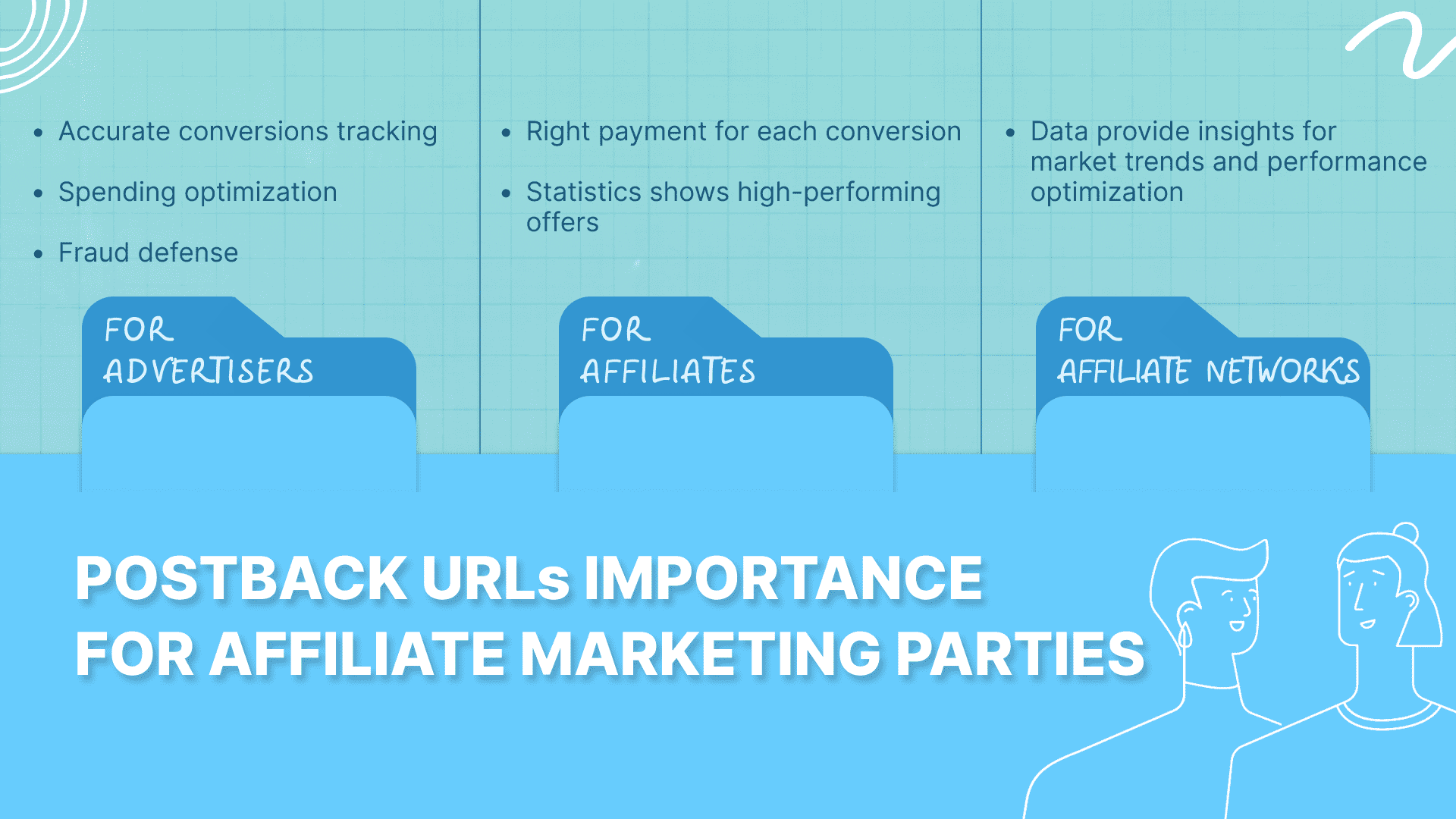
For advertisers
Postback URLs enable advertisers to accurately track and attribute conversions to the right affiliates, ensuring cost-effective spending and fraud prevention. This server-side tracking also enhances data security and allows for customized tracking of user behaviors and conversion events.
For affiliates
Affiliates benefit from reliable conversion tracking through Postback URLs, ensuring they are credited and paid accurately for their efforts. This enhances their ability to optimize campaign performance by focusing on high-performing offers based on detailed conversion data.
For affiliate networks
Affiliate networks gain from centralized tracking and reporting, which simplifies management and improves efficiency. Postback URLs help maintain marketplace integrity, ensure fair compensation, and provide valuable data insights for market trends and performance optimization.
Harnessing the power of Backlink URLs for greater income
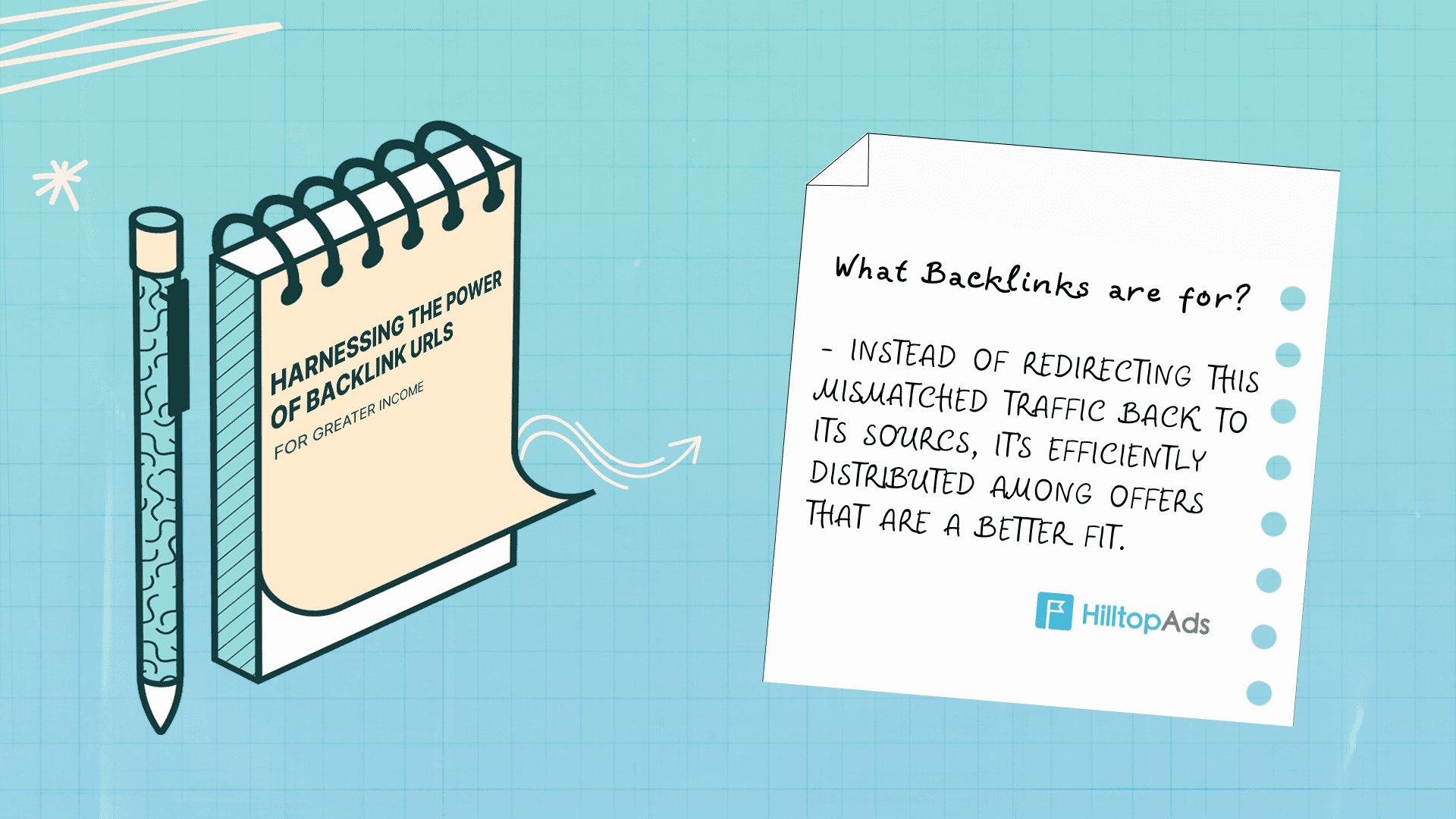
A Backlink, powered by the Direct Link algorithm, intelligently matches incoming users with the most appropriate offer available. This ensures that none of the incoming traffic is wasted, even if it doesn't directly align with the initial offer's criteria. Instead of redirecting this mismatched traffic back to its source, it is efficiently redistributed among offers that are a better fit.
There's no need for manual selection of offers or the deployment of numerous links. By incorporating a single Backlink into an active campaign, you can streamline the process, maximizing revenue while saving considerable time. This approach not only enhances the effectiveness of your traffic management but also optimizes the monetization of your digital assets.
The Backlinks mechanics explained
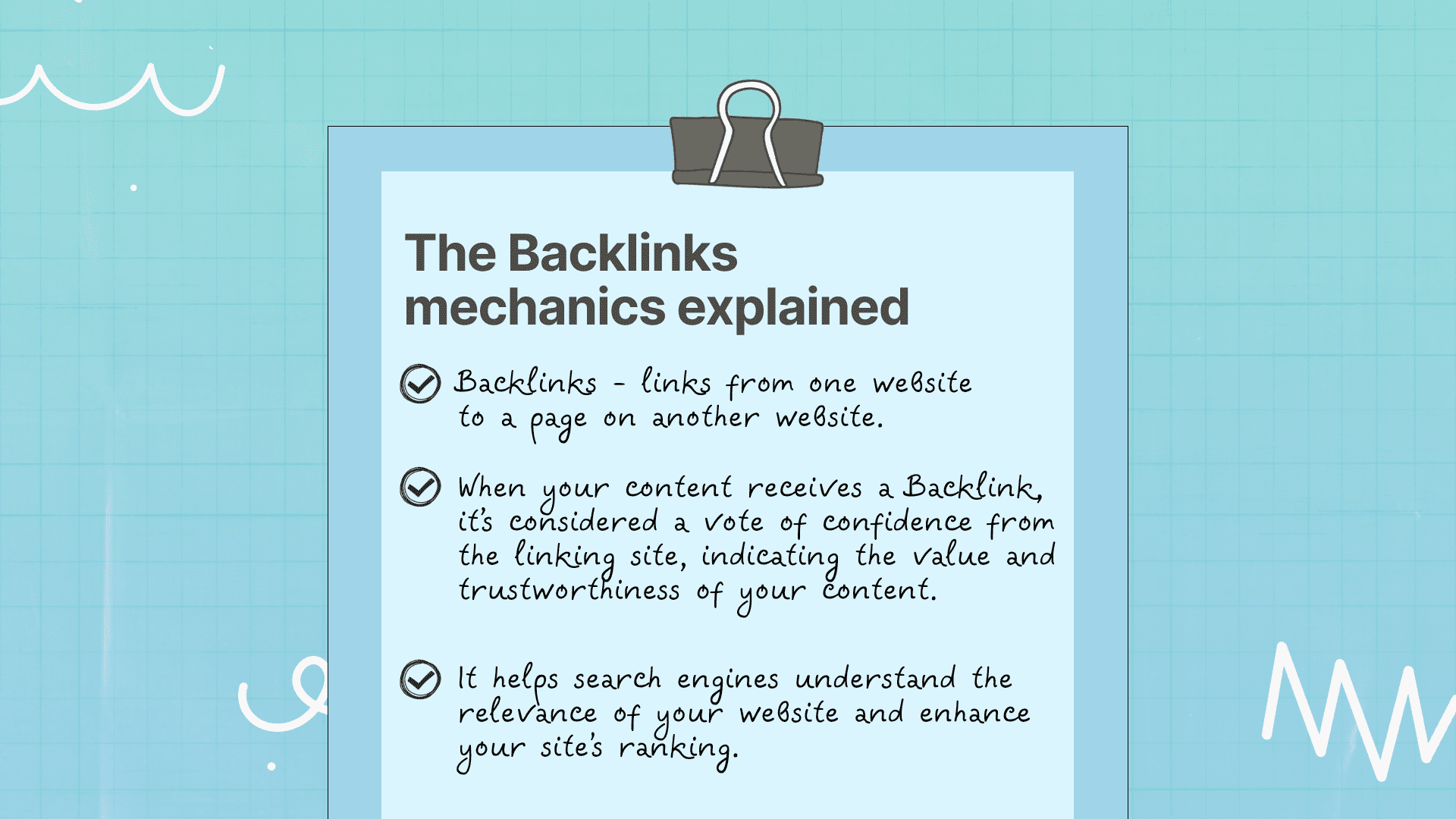
Backlinks, which are links from one website to a page on another website, play a crucial role in search engine optimization (SEO). They act as a signal to search engines that others endorse your content, significantly influencing your site's ranking in search engine results pages (SERPs). Essentially, when your content receives a Backlink, it's considered a vote of confidence from the linking site, indicating the value and trustworthiness of your content.
The impact of a Backlink largely depends on the authority and relevance of the linking site. High-quality Backlinks from reputable and pertinent sites can greatly enhance your site's visibility and ranking. Search engines utilize web crawlers to discover new Backlinks, assessing their quality based on the credibility of the linking site and the context of the link. This process helps search engines determine the authority your site holds and how it should rank in search results.
Backlinks are foundational to SEO because they help search engines understand the relevance and authority of your website. A strong Backlink profile, marked by high-quality and relevant links, significantly boosts your site's perceived trustworthiness and authority, improving its position in search results and overall online visibility.
Essential tips for effective Backlink usage
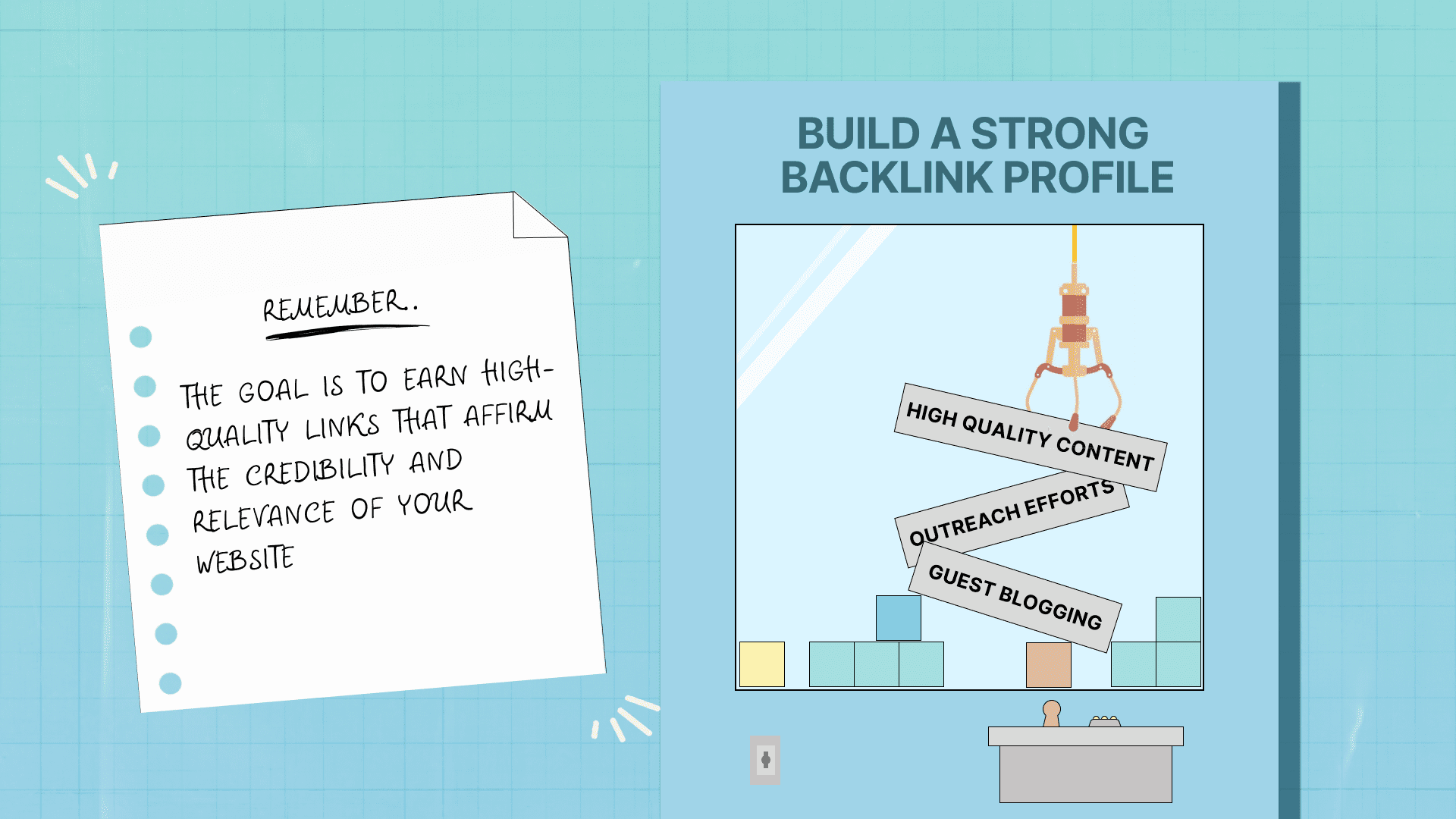
Utilizing Backlinks for ongoing traffic generation is highly effective. It's advisable to set up a flow in the tracking system to redirect users who don't align with the primary offer's requirements.
While Backlinks can serve as a main revenue-generating mechanism, it's important to recognize that offers can vary, feature distinct compensation rates, and might not perfectly match the demographic of the offer being evaluated. Backlinks do not provide the flexibility to choose specific offers or identify the most converting one.
To build a strong Backlink profile, focus on creating high-quality content that naturally attracts links from other websites. Additionally, outreach efforts, such as contacting other site owners to share your content or participating in guest blogging, can be effective strategies for earning valuable Backlinks. Remember, the goal is not just to increase the number of Backlinks, but to earn high-quality links that affirm the credibility and relevance of your website. This approach not only enhances your site's SEO but also its overall reputation and visibility online.
Final thoughts
Mastering Postback URLs in affiliate marketing and enhancing their efficiency with strategic Backlinks are crucial for precise conversion tracking and campaign optimization. This approach allows for detailed performance analysis, enabling marketers to refine strategies and achieve higher investment returns. To get from links to riches, invest in integrating Postback URLs with strategic Backlinking efforts. The integration of accurate tracking via Postback URLs with high-quality Backlinks boosts both the credibility and visibility of affiliate offers.
For sustained success, staying updated with affiliate marketing trends and adapting to new technologies is vital. Focusing on valuable content and effective link-building strategies can significantly improve tracking accuracy and campaign results, leading to more effective marketing efforts and better outcomes.
FAQs about Postback and Backlink URLs

What is a Postback link?
A Postback link is a URL that is called by an advertiser or a server to transmit data about an action (such as a sale or signup) back to another server or tracking system. This is often used in affiliate marketing to track conversions and the performance of affiliate campaigns in real time.
How do Postback links work?
When a user completes a specific action (like making a purchase) on a website, the advertiser's server sends a request to the Postback URL with details about the transaction. This URL, configured by the affiliate or tracking platform, receives the data and records the action, attributing it to the correct affiliate or campaign based on tracking parameters.
What are Backlinks, and why are they important for Postback links?
Backlinks are links from one website to another. In the context of Postback links, Backlinks can help improve the visibility and authority of the tracking or affiliate platform's domain. High-quality Backlinks can increase the domain's search engine ranking, making it more likely to be found by potential affiliates or partners.
Are there any services to help manage and optimize Postback links and Backlinks?
Yes, HilltopAds have integration with several well-known tracking services:
- BeMob,
- Keitaro,
- AdsBridge,
- AppsFlyer,
- Voluum,
- RedTrack,
- Binom,
- Peerclick.
How does link building with Backlinks affect the SEO of my platform?
Link building can significantly impact your SEO by improving your site's authority, which in turn can increase your ranking in search engine results pages (SERPs). A higher ranking can lead to more organic traffic, more potential affiliates discovering your platform, and ultimately, more conversions.
By focusing on these aspects, you can effectively utilize Postback links and maximize their effectiveness through strategic Backlinking, enhancing both your affiliate tracking capabilities and your platform's visibility and authority online.
